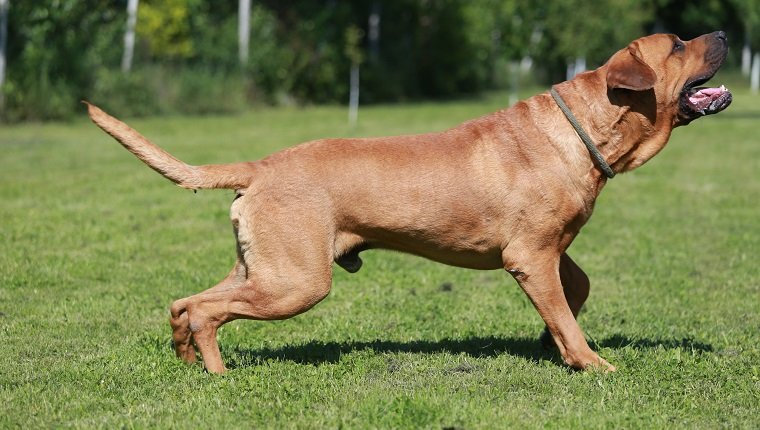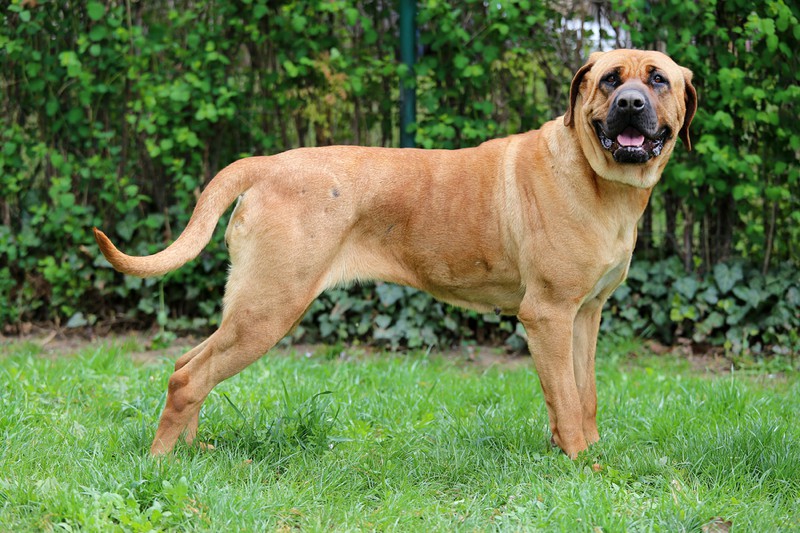
Developed in Japan beginning in the middle of the nineteenth century, the Tosa-Inu is a breed of combat dog also known as the Japanese Mastiff. Those Tosas produced in Japan stay closer to the original type, at roughly half the size, but those raised outside of Japan were crossbred with enormous and gigantic breeds like the Great Dane and Mastiff, producing exceptionally large individuals. Many places label this breed as hazardous, therefore having one is regulated and requires a license in the United Kingdom and Ireland. A well-trained, self-assured Tosa owner may help to mold a Tosa into a gentle giant. Without proper socialization and training, however, hostility against other animals and strangers may become serious problems.
Because of the high financial and time commitment involved, this breed is not advised for households with children or other pets. Activities like cart-pulling provide more rigorous exercise than merely lead walking or jogging, and are enjoyed by Tosas as a means of warding off boredom and dissatisfaction. Due to its big size and the fact that it is a mastiff, the Tosa-Inu is not the best choice for an apartment dweller. The average lifespan of a dog of this breed is between 10 and 12 years.
History and Background
Even today, dog fighting competitions are often organized and financed by the yakuza, the Japanese mafia, especially in rural regions, where the sport has a long history of popularity. The Tosa-Inu, which has traditionally been used in these competitions, embodies the attributes of a bold, aggressive, and strong dog. Animal rights activists are pushing to get this “sport” outlawed because of the high number of injuries and fatalities it causes to its participants. The breed originated from the molosser dog, a huge mastiff that has served as a guard dog and fighting companion throughout Asia and Europe for millennia. The current, standardized version of the breed in Japan emerged in the middle of the nineteenth century.
After this period, dogs shipped from Japan to Europe were mixed with bigger breeds one after another, starting with the Bulldog and ending with the Great Dane, creating a western version of the breed that is much larger and more imposing than its Japanese ancestors. Even though hundreds of litters were being produced yearly in the breed’s origin in the middle of the twentieth century, the breed has never gained widespread popularity elsewhere. The potential for behavioral issues and assaults on both animals and people is a major factor that has driven several nations to prohibit or regulate the possession of Tosas.
Both the possession and importation of Tosa-Inus in the United Kingdom and Ireland are illegal without a court order, since both countries see the breed as hazardous and have prohibited it from public housing. Neither the United Kingdom’s nor the United States’ Kennel Clubs recognize the Tosa, and the breed standard in use is rather the one established by the Federation Cynologique Internationale.
Appearance

The Tosa, like the Great Dane from which it was developed, is a large dog, yet it conducts itself with grace and poise despite its size. It has a robust, square snout that tapers to a prominent halt at the base of its wide cranium. Extremely strong jaws and teeth are essential to the breed’s reputation for having a flawless scissor bite free of any overbite. The ears are tiny and narrow, and they rest close to the side of the head on the high head shape. The eyes are tiny, dark brown, and normally have a calm look.
The Tosa’s neck is especially well-muscled; it has a large muscular arch and a dewlap of superfluous skin that helps the dog turn on its assailant even while it’s being restrained. Muscles extend all the way down to the base of the tail from the very high withers. The somewhat well-sprung, deep chest results in a neatly tucked belly.
The limbs are properly aligned, allowing for athleticism and the best possible use of muscle strength. The breed features thick, sturdy bones and compact, well-padded paws. The Tosa is characterized by its short, tough, and harsh hair. It’s not uncommon to see a few different hues:
- Red
- Fawn
- Apricot
- Black
- Brindle
Although the breed standard does not actively discourage them, little white spots on the chest and feet are not desirable. Male Tosas average 60–65 centimeters (24–26 inches) in height at the withers, while females are on average 55–58 centimeters (21–22 inches) in height (22–23 in). Depending on their build and genetic traits, both sexes may be anywhere in the 38-60 kg (84-132 lb) weight range.
Personality and Character
An emotionally stable Tosa-Inu is devoted to its family and seldom displays any signs of aggression. Most people, after getting enough exercise, will spend most of their time lounging at home. But they are also wary and angry toward strangers, and they react violently to any perceived danger. This hostility may be difficult to manage and redirect if the dog has not been properly socialized, leading owners to restrict their dog’s interaction with other people out of worry for their safety.
Many Tosas have a strong urge to hunt, and as a result, they go after small animals and even other dogs. Because of this, they tend to do best as an only pet. The breed may be too dominant if handled by someone without expertise, and it may dislike the owner’s feeble attempts to exert authority. Tosas, on the other hand, are loyal to people they believe to be leaders of their pack. Instilling a clear and well-defined pack structure from an early age is crucial for this reason.
Trainability
Intelligent, yet intransigent, that’s the Tosa-Inu. Many dogs have strong preferences in how they should act, and it might take a lot of work to change their mind. Owners of such a huge and potentially dangerous breed must be willing to put in the time and effort necessary to ensure their dogs exhibit good behavior and have a high degree of obedience training. Help from an experienced dog trainer is essential, particularly when starting out with a young Tosa.
It is crucial to provide extensive human-to-puppy socialization for pups. By giving the young dog with pleasant experiences at each contact, socialization with strangers may be facilitated by inviting friends and extended family to spend time with the pup, taking them on walks, and offering treats and praise. While it is true that socializing with other dogs is helpful, the breed is not usually trusted by members of its own species, therefore the payoff from such encounters may be lower. Games like tug-of-war, which may inadvertently foster aggression between dog and owner, should be avoided because of the breed’s size and power.
Health
The world of dog fighting is ruthless, yet the selective breeding required to create competitive dogs, along with more modern cross-breeding in the West, has resulted in a breed with few serious health concerns.
Irritation of the Skin Due to Allergies
Many different things, from dust mites to dietary ingredients, might trigger allergic skin diseases in Tosas. Typical allergy symptoms include secondary skin infection, hair loss, and scabbing after first indications of redness and irritation on the ears, face, paws, and perineum. Allergic triggers may be identified using a combination of skin scrapings, diet and drug trials.
Emotional and Behavioral Disturbances
As has been established, the Tosa has a bold character and an aggressive bent. For this reason, many dogs are given up for adoption every year. Large, violent adult Tosas are very difficult to rehabilitate, therefore it’s better to start socializing and teaching them young to avoid this problem.
Asplenia of the Elbow
The Tosa-Inu is one of several giant dog breeds prone to developmental problems of the elbow joints. Joint discomfort and lameness may appear as early as five months of age due to aberrant development in one or more parts of the joint. Due to the breed’s naturally high pain tolerance, symptoms may not present themselves until maturity, by which time the arthritic alteration is likely to be permanent.
Dysplasia of the hip
In the same way as elbow dysplasia is often first observed in younger dogs, hip dysplasia is often first detected in older dogs, and the accompanying joint incongruity ultimately leads to osteoarthritis of the hip joint. Because of the heritable nature of hip and elbow dysplasia, scoring systems have been in place for years to cull unhealthy people from the population. Anyone looking to buy a Tosa must demand to see their parents’ score certificates.
Hyperkalaemia
Several of the huge Japanese breeds have been documented as suffering from this illness, however it seldom causes any serious symptoms. Onion and garlic use may increase already raised blood potassium levels, which may be discovered in silent cases by normal blood tests. Lethargy and cardiac arrhythmias may be seen in severely afflicted individuals, although these symptoms are uncommon.
Hypothyroidism
Overweight and thinning hair are symptoms of an underactive thyroid gland, which is typical in the breed. As we’ve seen, allergy symptoms and dermatitis symptoms sometimes overlap; thus, it’s common practice to check thyroid hormone levels in the blood when investigating either ailment.
Activity and Exercise Levels
Tosa-Inus are content to lounge about for long periods of time, yet they need a significant amount of exercise each day. Each day, there should be time set up for walking or jogging, and there should also be a safe outdoor area available for use. A Tosa should ideally have more strenuous exercise, such dragging a cart, or be given a weighted doggie backpack to wear on walks. The dog will get more pleasure from its daily routine and exhibit less aggressive or unwanted behavior with the help of such exercise tools.
Grooming
The breed’s short, coarse coat makes it easy to maintain without much effort. Once a week, brushing will help maintain the skin and hair healthy, and a weekly wash will help get rid of any stubborn dirt and deodorize. Tosas drool a lot and shed a little bit all year round, albeit not as much as other mastiffs. Because of this, taking care of a Tosa’s house may be more work than grooming the dog himself, and having a supply of baby wipes on hand will help with the inevitable puddles of drool before they dry into furniture and carpets.
When compared to other dog breeds, Tosa-Inus have very tough nails, and they tend to be a dark color. The pads may be damaged if they are allowed to grow unchecked, therefore regular trimming is essential. For this, you’ll need a sturdy pair of nail clippers, and it’s best to start the practice of clipping your puppy’s nails early on so he or she doesn’t grow to dislike it. Since the sensitive quick under black nails cannot be seen, it is recommended to take little, frequent pieces rather than bigger, infrequent chunks, when the chance of striking this vascular structure rises.
Celebrity Tosa inos
Those Tosas who are very successful in the dog-fighting arena are given the honorific “Yokozuna,” a term also used in sumo wrestling, elevating them to the status of celebrities in Japan. Like their human counterparts, these canine sumos wear patterned linen and braided rope.
Cross-Breeds
Tosa hybrids are very uncommon to come across for sale in the United Kingdom or Ireland due to their restricted status and scarcity outside of Japan. The dogs that are crossed often include the Presa Canario, Fila Brasileiro, and Dogo Argentino, all of which are seen as dangerous breeds in their own right.